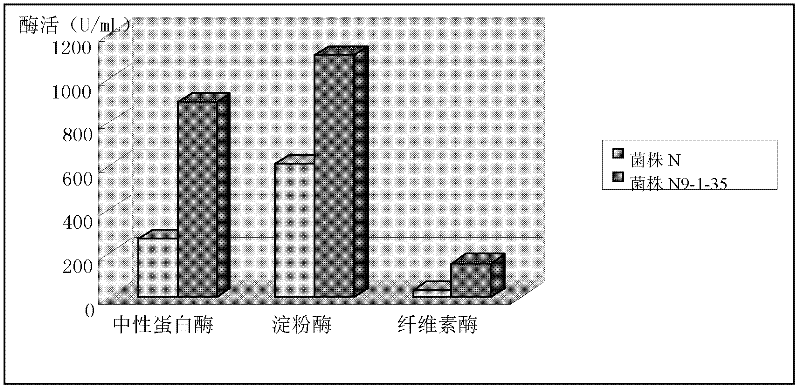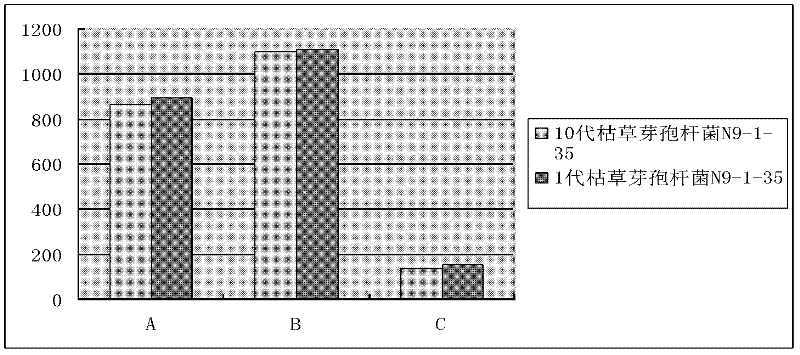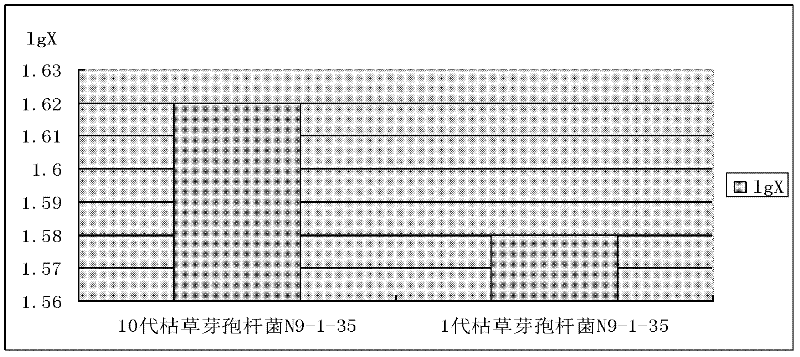Bacillus subtilis bred by space mutation breeding technology and application of Bacillus subtilis
A technology of Bacillus subtilis and aerospace breeding, applied in the biological field, can solve the problems of affecting the feeding effect, poor acid resistance, and affecting the enzyme activity of the product, so as to improve feed conversion rate, reduce feed cost, and improve digestion and absorption Effect
- Summary
- Abstract
- Description
- Claims
- Application Information
AI Technical Summary
Problems solved by technology
Method used
Image
Examples
Embodiment 1
[0029] Embodiment one, the screening of strain
[0030] 1. Materials and methods
[0031] 11 Samples: soil, hay, animal intestinal contents, feces of cattle, sheep, geese and other animals, cattle rumen contents.
[0032] 1.2 Screening medium:
[0033] Screening medium for amylase-producing strains: 1.0% corn starch, 0.3% beef extract, 0.5% peptone, 2.0% agar powder, pH 7.2-7.4, sterilized at 121°C for 30 minutes.
[0034] Screening medium for neutral protease-producing strains: soybean protein powder 1.0%, beef extract 0.5%, dipotassium hydrogen phosphate 0.05%, magnesium sulfate 0.05%, calcium chloride 0.05%, Tween-800.1%, agar powder 2.0%, pH7.2~7.4, 121℃, sterilize for 30min.
[0035] Screening medium for cellulase-producing strains: carboxymethyl cellulose 1%, peptone 0.5%, dipotassium hydrogen phosphate 0.05%, magnesium sulfate 0.02%, calcium chloride 0.01%, ferric chloride 0.02%, agar powder 2.0% , pH 7.2-7.4, sterilized at 121°C for 30 minutes.
[0036] Screening ...
Embodiment 2
[0050] Embodiment two, identification and safety test of bacterial classification
[0051] 1. Materials and methods
[0052] 11 strains: The microorganisms isolated from cow dung and goose dung samples were screened out after primary screening and secondary screening, and a total of 2 strains with high enzyme activity such as neutral protease were screened out, and the numbers were N and E respectively.
[0053] 1.2 Routine biochemical identification of bacteria: Unless otherwise specified, tests for general morphology, physiological and biochemical properties were carried out with reference to "Bergey's Bacterial Identification Manual" (9th edition) and "Microbiology Experiment Manual".
[0054] 1.3 Safety test: different concentrations (1×10 8 cfu / mL, 1×10 9 cfu / mL, 1×10 10 cfu / mL, 1×10 11 cfu / mL) of the N bacterial strain and the fermented liquid of the E bacterial strain were injected intraperitoneally to mice, 10 in each group, and observed continuously for 1 week to ...
Embodiment 3
[0061] Embodiment three, the selection and breeding of N strain mutagenization bacterial classification
[0062] 1. Materials and methods
[0063] 11 strains: Bacillus subtilis N strain
[0064] 1.2 Medium
[0065] 1.2.1 Liquid seed medium
[0066] 10g peptone, 5g sodium chloride, 5g beef extract, 1000mL water, pH7.2. Sterilize at 121°C for 30min.
[0067] 1.2.2 Liquid fermentation medium
[0068] Glucose 5g, peptone 10g, sodium chloride 5g, beef extract 5g, water 1000mL, pH7.2.
[0069] Capacity: 100mL in a 500mL Erlenmeyer bottle, sterilized at 121°C for 30min.
[0070] 1.3 Enzyme activity determination method and apparatus are the same as in Example 1.
[0071] 1.4 Mutagenesis method:
[0072] The 18th returnable science and technology satellite launched by China's Jiuquan Satellite, after 18 days of orbiting, in the special environment of space microgravity, strong radiation, high-energy particles, alternating magnetic field, etc., the genetic mutation of the bacter...
PUM
 Login to View More
Login to View More Abstract
Description
Claims
Application Information
 Login to View More
Login to View More - Generate Ideas
- Intellectual Property
- Life Sciences
- Materials
- Tech Scout
- Unparalleled Data Quality
- Higher Quality Content
- 60% Fewer Hallucinations
Browse by: Latest US Patents, China's latest patents, Technical Efficacy Thesaurus, Application Domain, Technology Topic, Popular Technical Reports.
© 2025 PatSnap. All rights reserved.Legal|Privacy policy|Modern Slavery Act Transparency Statement|Sitemap|About US| Contact US: help@patsnap.com



